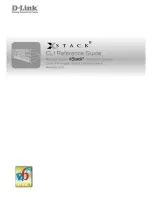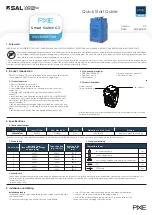
143
multicast traffic. If there is more than one router/ switch on the LAN performing IP
multicasting, one of these devices is elected “querier” and assumes the role of querying the
LAN for group members. It then propagates the service requests on to any upstream
multicast switch/router to ensure that it will continue to receive the multicast service. This
feature is not supported for IGMPv3 snooping.
◆
RV
– The Robustness Variable allows tuning for the expected packet loss on a network. A
port will be removed from receiving a multicast service when no IGMP reports are detected
in response to a number of IGMP queries. The robustness variable sets the number of
queries on ports for which there is no report. (Range: 1-255; Default: 2) Routers adopt the
robustness value from the most recently received query. If the querier's robustness
variable (QRV) is zero, indicating that the QRV field does not contain a declared
robustness value, the switch will set the robustness variable to the value statically
configured by this command. If the QRV exceeds 7, the maximum value of the QRV field,
the robustness value is set to zero, meaning that this device will not advertise a QRV in
any query messages it subsequently sends.
◆
QI
– The Query Interval is the interval at which MLD General Queries are sent by the
Querier. (Range: 1-255 seconds; Default: 125 seconds) An MLD general query message is
sent by the switch at the interval specified by this attribute. When this message is received
by downstream hosts, all receivers build an MLD report for the multicast groups they have
joined.
◆
QRI
– The Query Response Interval is the Max Response Time advertised in periodic
General Queries. The QRI applies when the switch is serving as the querier, and is used to
inform other devices of the maximum time this system waits for a response to general
queries. (Range: 10-31744 tenths of a second; Default: 10 seconds)
◆
LLQI
– The Last Member Query Interval (RFC 3810 – MLDv2 for IP) is used to configure
the Last Member Query Interval for IGMP. This attribute sets the interval to wait for a
response to a group-specific or group-and-source-specific query message. The overall
time to wait for a response (Last Member Query Time) is the value assigned to LLQI,
multiplied by the Last Member Query Count (which is fixed at 2). (Range: 1-31744 tenths of
a second in multiples of 10; Default: 1 second)
When a multicast host leaves a group, it sends an IGMP leave message. When the leave
message is received by the switch, it checks to see if this host is the last to leave the group
by sending out an IGMP group- specific or group-and-source-specific query message, and
starts a timer. If no reports are received before the timer expires, the group record is deleted,
and a report is sent to the upstream multicast router.
A reduced value will result in reduced time to detect the loss of the last member of a group or
source, but may generate more burst traffic.
This attribute will take effect only if IGMP snooping proxy reporting is enabled.
◆
URI
– The Unsolicited Report Interval specifies how often the upstream interface should
transmit unsolicited IGMP reports when report suppression/proxy reporting is enabled.
(Range: 0-31744 seconds, Default: 1 second)
Содержание GEP-1070
Страница 80: ...80 authentication from any point within the network...
Страница 168: ...168...
















































